Urine directors
1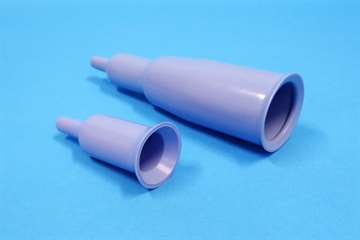
Large and small male urine directorUrine directors are small portable devices that provide a conduit so that the flow of urine can be directed into a toilet or other receptacle.
Who are urine directors good for?
Urine directors can help direct the flow of urine for a man who has a short or retracted penis. This is common after treatment for prostate cancer. Some men have a urine stream that sprays, and a urine director can assist with accurate direction of the stream. Some men also find female urine directors can be a useful alternative.
People with poor hand control may find urine directors difficult to use. They may have difficulty positioning them correctly over the urethral opening or difficulty folding the flat-packed designs.
When do urine directors work best?
There is no research evidence about how well these devices work. However, if you have difficulty directing the stream of urine, a urine director might be suitable for you. As they are small and portable, they may be useful when travelling.
What other products could ‘mix and match’ well with urine directors?
Urine directors do not have any storage capacity. However, some versions attach to a urine collection bag, so may be suitable for use as a urine collection device (similar to a handheld urinal). The bag can be rinsed and re-used.
Can urine directors be reused?
Male urine directors are made from plastic and are designed to be washed and reused.
Disadvantages of urine directors
If you are unable to position it properly, then urine may escape around the urinal and wet your hands or clothing.
Where can I get a urine director?
We are only aware of one UK-based supplier of this type of device for men. Please let us know if there are others!
Handheld urinals
Handheld urinals are portable devices that can be used when access to a toilet is not possible, convenient or safe.
2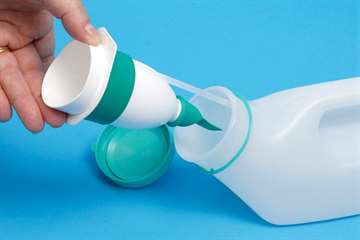
Hand held urinal with non-spill adaptor14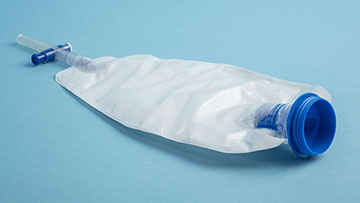
Disposable travel urinal - shown with lid removed
| More likely to suit you if... |
Less likely to suit you if... |
- You have urgency, and poor mobility prevents you from accessing the toilet
|
- You are unable to empty the urinal independently
|
- You are able to stand or crouch
|
- Your balance is poor for standing use of the urinal
|
- You are able to move to the edge of the chair or bed
|
- You have difficulty reaching forward and have impaired wrist function
|
- You have reasonable hand control
|
- You have poor memory and mental function
|
When might a handheld urinal be useful?
Handheld urinals can give people the opportunity to independently manage toileting in a safe and dignified way either at home or when away.1
Handheld urinals are particularly useful in the following circumstances:
-
When there is an urgent and/or frequent need for bladder emptying to avoid incontinence occurring.
-
Where limited mobility or flexibility makes using the toilet difficult.
-
When going on long journeys or any other time when access to a toilet is difficult.
-
To avoid dependence on a carer if unable to use the toilet independently.
Selecting a handheld urinal
Male handheld urinals are designed specifically to accommodate the male anatomy. Most are similar in shape and size, with a narrowed opening (the ‘neck’) into which the penis is placed and a wider lower section in which urine is collected. These types of urinals are commonly referred to as ‘bottles'. Some men recycle household items such as plastic milk bottles and other containers as urinals.2
Before deciding on which type of handheld urinal to use, think about where it will be used, how easy it will be to use, and whether it can be emptied easily after use. An effective hand-held urinal must enable complete bladder emptying in comfort and safety. Using the urinal should not require excessive physical effort and the urinal should be easy to empty completely without spillage.
When choosing a handheld urinal, there are several factors and features to consider:
-
Varied designs – urinals are available in different shapes, sizes and colours
-
Use in different postures - some urinals are better in particular postures, like standing or sitting. Some have a flatter, narrower end so that they can be more easily put into position, especially if flexibility and leg abduction (moving your legs apart) is difficult.
-
Handles – handles of varying designs are available to assist with grip and positioning.
-
Lids or non-spill features – some urinals have lids or other features to help prevent spillage during and after use. Sachets of super absorbent polymer (SAP) can be placed in a urinal to soak up the urine, reducing the risk of spills/leaks from the urinal. Traditional narrow necked male urinals can accept a non-spill adaptor, which prevents spillage even if the urinal is tipped upside down.
-
Collection bag attachment - some urinals can be attached to a urine collection bag, which increases the functional capacity of the urinal. This is helpful if you are unable to empty the urinal yourself or during the night where greater capacity is needed after for multiple use of the urinal.2
-
Reusable urinals are usually made from plastic or, less commonly, metal.
-
Disposable urinals these are made from cardboard and are often used in hospitals for hygiene reasons and to reduce the need for washing.
-
Reusable travel urinals are small, collapsible urinals that can fit in a pocket or small bag.
-
Single use travel urinals – these are small pouches designed to be easy to pass urine into and that contain super absorbent polymers that absorb and contain the urine. After use, the pouches are closed and disposed of when next convenient. They are designed for use by travellers and others who may find themselves occasionally unable to access a toilet, but can also be useful for anyone who experiences frequent or urgent need to pass urine.
In some countries it may be possible to borrow a urinal from a urinal lending library. Ask your healthcare professional if they have sample urinals that you can try out.3
Will I have difficulty using a handheld urinal?
Most male urinals are easy to use in most positions as long as you can position the base of the urinal downwards so that gravity helps the urine to flow away from your body.
Some rigid male urinals may be rather unstable, particularly when being used in bed. Urinals with a broad flat base can be more stable and less likely to spill.2
If you find that urine sometimes leaks from the opening of the urinal when you are using it or when it is being removed afterwards, it can be useful to use a chair protector or bed pad under the urinal. Using sachets of super absorbent polymer or attaching a drainage bag to the urinal can also help to prevent leakage.
You may find that handheld urinals are heavy and difficult to manage when full, especially if your hand control or strength is poor. Some urinals have larger, easier to grip handles, which can be helpful, or can be adapted to increase the thickness of the handle.
Men with a short or retracted penis (often a problem after some types of surgery, e.g. prostate surgery) or men with a large tummy who are unable to easily see or reach the penis may find some female handheld urinals easier to use as they have a wider opening than male urinals.
You can practice holding and placing a urinal without the need to remove clothing. You may find that making some alterations to your clothing (e.g. replacing zips with Velcro) can help you to use the urinal quickly if needed.
Emptying and cleaning reusable urinals
Handheld urinals can be emptied down the toilet. Some have a spout or a plug for easier emptying or a urine collection bag attached.
If you are at home and the urinal is only for your use, you should clean it thoroughly with soap and water between uses. For added hygiene, you can also use an anti-bacterial spray. The manufacturer’s instructions on specific cleaning requirements should be followed.
If you have taken your urinal with you into hospital it may need to be autoclaved to reduce the risk of cross-infection. Check the manufacturer’s instructions to ensure that your urinal can be cleaned this way without it becoming damaged.
Disposing of single-use urinals
Cardboard urinals are for single-use only. They should be emptied after use, wrapped in paper and disposed of in the usual household or clinical waste. In hospital, where disposable urinals are mainly used, they are often disposed of in a macerator.
Urinals and bowel leakage
Some designs of female urinals can be used to collect stool, which can be useful if you know that you need to open your bowels but have very little warning. If you have bowel leakage with no warning, they are unlikely to be useful.
You can find out about other products for bowel management that might be more suitable by using the product selector.
Where can I get a handheld urinal?
Many types are available through retail outlets such as pharmacies and supermarkets, the internet or direct from suppliers. Not all products are available worldwide. See below for links to suppliers and products in your part of the world.
Bedpans
3
Bed panBedpans are portable devices used for passing urine or stool while in bed or on a chair. There are three broad designs of bedpan:4
-
The concave pan has a rounded triangle shape that slopes from back to front and has a curved seat
-
The cutaway pan has a rounded triangle shape with a flatter seat and rolled edges that allow for hand gripping
-
The shovel shape or fracture pan is a wedge or rectangular shape. One end is flattened to go under the person, and there is a handle at the other end
Most bedpans are made of plastic or metal. Some are disposable and made from cardboard and should be thrown away after use.
| More likely to suit you if... |
Less likely to suit you if... |
- You are unable to use any other alternative e.g. a toilet or commode
|
- You are able to sit or to transfer from a bed to a chair, in which case a handheld urinal or a commode may be a more dignified and effective way of toileting
|
Bedpans and bowel leakage
Bedpans can be useful if you know that you need to open your bowels and have some warning. If you have bowel leakage with no warning, they are unlikely to be useful.
You can find out more about products for bowel management that might be more suitable by using the product selector.
Emptying and washing bedpans
Most bedpans are designed to be washed and reused and should be thoroughly cleaned in between each use for hygiene and to reduce odour.5
The contents of the bedpan should be emptied into the toilet. This can be difficult as some bedpans are quite heavy and, when full, are heavier still. This is a consideration if you have a helper who might find this difficult.
Some bedpans have a spout or a plug to assist with easier emptying down the toilet.
At home or in other settings where a bedpan is only being used by one person, then it can be washed between uses with hot soapy water followed by an anti-bacterial spray. Toilet bowl cleaning products, containing bleach or antibacterial ingredients, can be used but their effect on reducing odour is unclear. Bedpan liners are available for easy disposal of waste.
The size and shape of some bedpans may make it difficult to wash in a standard sink or basin in the home. If this is the case, it could be washed in a bath or shower.
In hospital or other environments where bedpans may be used by more than one person they should be autoclaved or washed in a special bedpan washer to reduce the risk of cross-infection.
Disposable bedpans
Single use cardboard bedpans are often used in hospitals or care homes. They are disposed of after use often in a macerator.
If used at home, they should be emptied and wrapped in paper for disposal. In some countries this may be in household waste, whereas other countries have stricter rules about the disposal of clinical waste.
Disadvantages of bedpans
Using a bedpan for toileting is widely considered undignified and embarrassing6 and usually requires a helper.7 A bedpan normally does not allow the user to assume a position that makes urination or defaecation easy, and lack of privacy can also make bedpan use difficult for many.6 Personal cleaning after use of a bedpan can also be difficult.
Bedpan use can also be painful for some people, especially if the pan is not removed promptly after use.8
If you are unable to position the bedpan properly then it may leak. Some are easier to position than others, depending on the size and shape of the pan. Lifting your bottom off the bed will make positioning the bedpan easier. It can be difficult to remove and transport a bedpan without spillage and odour may be a concern.
Where can I get a bedpan?
They are available through retail outlets such as pharmacies and supermarkets, the internet or direct from suppliers. Not all products are available worldwide. See below for links to suppliers and products in your part of the world.
Commodes
22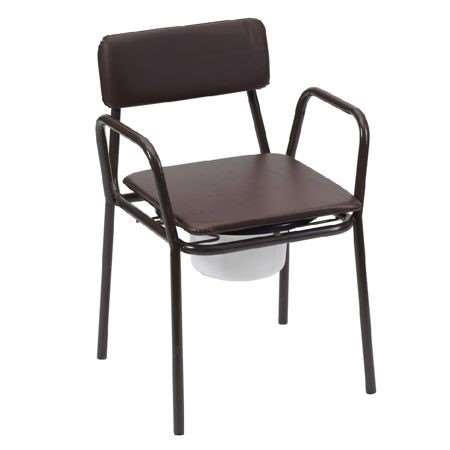
CommodeCommodes are portable toilets, consisting of a frame supporting a toilet seat with a disposable or reusable pan or bowl beneath to receive urine or stool. Although it is always preferable to use a conventional toilet whenever possible, a commode can be very useful and can enable independent living with limited help.
Commodes are especially useful for people with reduced mobility who find it difficult to get to a conventional toilet because they can be positioned in a place convenient for the user. For example, a commode can be placed next to the bed, or downstairs in a house where the only available toilet is upstairs and inaccessible to the user. They should always be positioned against a heavy piece of furniture or a solid wall to ensure the users safety.
Commodes are available in a range of designs.9 Before getting a commode, you should think about how, where and by whom it will be used. There are several different types:
-
Static commodes are solidly built like a chair. Often these commodes have a discreet appearance, being designed to resemble normal furniture, with the pan hidden under a removable seat.
-
Mobile commodes are lighter and can be moved easily. Some have wheels that can be locked for safety when the commode is in use.
-
Adjustable height commodes allow the user greater comfort and safety, with minimal sitting and rising.
-
Multipurpose commode seats can be used on their own with their pan in place but can also be positioned over the normal toilet for greater comfort, privacy and safety. These can often also be used as a shower chair for safer bathing, if you have an accessible shower or wet room.
-
Easy to clean - commodes are generally made from plastic and metal making them easier to clean. This is especially important in hospitals and care homes where contamination with faeces and cross–infection can be a problem.101112 Older commodes and those designed to resemble normal furniture are made from wood and can be more difficult to clean.
| More likely to suit you if... |
Less likely to suit you if... |
- You have urgency, and poor mobility prevents you from accessing the toilet
|
- Privacy is an issue e.g. When in hospital, when a shower chair may be preferable
|
| |
- You cannot use a commode safely (commodes can be unstable and tip backwards)
|
Selecting a commode
The usefulness of a commode depends largely on whether it can be used safely (with or without help) and whether it is acceptable to the user.
Occupational therapists are well-placed to make recommendations for toilet and bathroom areas, even without the need for an actual home visit, using digital photographs taken by family members and clinical information about the patient.13
There are some important questions to consider if you are planning to use a commode:
How mobile are you?
Commodes are easiest to get onto if you can stand and turn to sit down. Alternatively, you can transfer onto a commode directly from a seat or bed – some designs have removable or drop down arms so that they can be positioned next to the bed or chair for easier transfers. Very immobile people can be transferred using a hoist.
Can you sit safely on the commode independently or do you need help?
If you are unable to use the commode safely, you will need a helper who can ensure you are seated safely and to help you off the commode as soon as you are ready. People with disabilities often have poor upper body control and this is associated with an increased risk of falls.5
Can you fit comfortably on the commode?
Some larger, sturdier commodes are available for larger size people but width is often restricted by side handles, which are necessary for stability.
Do you find the idea of a commode acceptable?
People often find the look of commodes (even those designed to look like furniture) to be unacceptable, especially in social areas, for example, a sitting room. People are concerned about lack of privacy, and embarrassment, unpleasant smells and the poor physical appearance of some designs.12
Emptying and cleaning commodes
For hygiene and to reduce the risk of smell, it is best to empty and clean a commode after every use or as soon as is possible.
The removable bowl should be lifted out and urine and stool emptied into the toilet. A full commode bowl can be quite heavy and difficult to carry to the toilet without spillage. Some commode bowls have a spout to make it easier to pour urine into the toilet. Others are like a bucket with a lid and handle.
The bowl should be cleaned as you would a conventional toilet using your usual products and an antibacterial spray. Wiping around the frame and seat of the commode is recommended to reduce the risk of unpleasant odour.
Cleaning commodes is a particular problem in hospitals, where cross-infection is a risk.1012 If you are at home and have sole use of the commode, then you don’t have to worry about cross-infection.
Disadvantages of commodes
Some commodes have been found to be unstable and likely to tip backwards and can also be uncomfortable.10 If possible, try out a range of commodes before making a purchase and use one with arms.
The appearance of commodes makes them unacceptable for some people.914 If the look of the commode is important to you, choose a commode designed to look like furniture.
A commode in a room can be a source of odour, which can make their use unacceptable. 14 This can be minimised by timely emptying and cleaning.
Commodes can be associated with a lack of privacy, especially if you require someone to help you on and off the commode.
How much do commodes cost and where can I buy one?
Commodes can be relatively expensive. If your need for a commode is likely to be short-term, it may be possible to borrow one from a disability organisation or through your health care professional. The cost of commodes varies according to the design and which country you live in.
They may be available through retail outlets such as pharmacies, the internet or direct from suppliers. Not all products are available worldwide. See below for links to suppliers and products in your part of the world.
Toilet raisers and toilet frames
4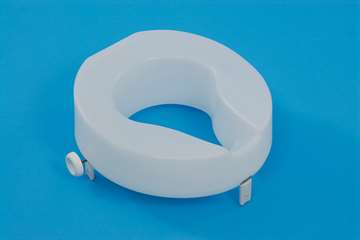
Raised toilet seat 9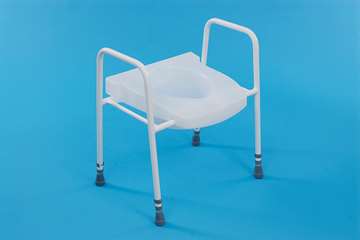
Toilet frame with raised seatToilet raisers increase the height of your usual toilet seat to make getting on and off easier, if moving between standing and sitting is difficult.
There are different types:
-
Simple, portable, moulded toilet seat raisers fit on the existing toilet seat.
-
Semi-portable toilet raisers comprise of a toilet seat supported by a frame with legs that sits around and over the existing toilet. Often their height is adjustable and they usually incorporate arms to improve stability, and ease of sitting and standing.
-
Permanent fixed toilet raisers are fixed securely over the existing toilet seat and cannot be removed easily.
-
Toilet frames without seats and with arms are placed around the existing toilet for ease of sitting and standing.
Care should always be used to ensure that the user can still touch the floor with their feet. Care should also be given when an individual has undergone recent hip or knee joint replacement surgery.
Cleaning a toilet raiser
Toilet raisers can be cleaned in a similar way to a toilet using your usual antibacterial products.
Disadvantages of toilet raisers
If you share the toilet you use with other people, a temporary toilet raiser may be more appropriate so it can be removed for other people’s use.
You may find it inconvenient if your needs change and you have a more permanent fixed toilet raiser fitted which is no longer suitable.
How much do toilet raisers cost and where can I buy one?
The cost of toilet raisers varies according to the design and which country you live in. They can be purchased from retail outlets such as pharmacies, the internet or direct from suppliers. In some countries they may be available through health and social care providers. Not all products are available worldwide. See below for links to suppliers and products in your part of the world.
Bottom wipers
21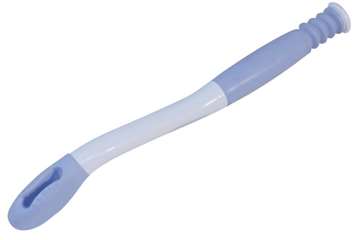
Bottom wiperA bottom wiper acts as an extension to your arm to assist with cleaning if you are unable to reach, for example, because of reduced arm length or function, poor hand control or reduced ability to turn around.
There are different makes of bottom wiper but they have a broadly similar design comprising of a handle with an angled arm (plastic or metal) and a serrated recess at the far end that is intended to grip the toilet paper. They are light and fairly portable (foldable versions with a case are available that you can put in your pocket/bag) and some have a larger, easy to grip handle.
Bottom wipers are a relatively low-cost product. A more expensive option for assisting you to clean yourself might be a bidet or bidet toilet.
You may find that using a bottom wiper with purpose-made moist toilet paper will make cleaning easier (not baby wipes, which cannot be flushed).
Cleaning a bottom wiper
Clean the bottom wiper thoroughly after use with soap and water and you can use an antibacterial spray.
Disadvantages of bottom wipers
You might find them hard to grip depending on how good your hand control is.
As you can’t see the area you are cleaning, it is possible that some residue stool may be left on the skin and may cause skin irritation and soreness, so regular washing is important.
How much do bottom wipers cost and where can I buy them?
Bottom wipers are a relatively cheap item. They may be available through retail outlets such as pharmacies, the internet or direct from suppliers. Not all products are available worldwide. See below for links to suppliers and products in your part of the world.
Bidets
Bidets are similar to a toilet pan but produce a jet of water which washes the genitalia and peri-anal area following use of the toilet. There is no research evidence about how efficient a bidet is at removing urine and faeces, but if you have a problem wiping yourself adequately after using the toilet, then a bidet could be very useful.
There are several types of bidet and bidet-like products:
-
Traditional bidets are separate items of sanitary-ware positioned next to the toilet. They have taps and a spout to control the flow and temperature of the water.
-
Bidet toilet seats replace a normal toilet seat and allow washing and drying using electronic controls. The controls can be on the side of the bidet or on a a separate wall-mounted or handheld remote control. These control a spout that can be adjusted to spray water in a direction right for you. There may be a choice of spray type as with modern shower heads. There is usually a drying function and some also have heated seats. Bidet toilet seats are electronic devices so you are recommended to check for a CE mark or another recognised manufacturing mark of safety for your country.
-
Bidet toilets can be plumbed in to replace your existing toilet. This option is considerably more expensive than other options but can be an investment if you have a long-term health condition.
-
Health faucets resemble a small shower hose that is fixed to the wall near to the toilet and allows cleaning with water. This system requires good use of your hands and the ability to squat over the toilet.
-
A bidet or health faucet combined with a raised toilet seat if a traditional bidet is too low for easy sitting and standing, combining a bidet or health faucet with a raised toilet seat may help.
Cleaning a bidet
Bidets can be cleaned in the same way and using the same products as a toilet.
I have bowel leakage can I use a bidet?
A bidet could be very useful if you have bowel leakage, because thorough cleaning is important to prevent skin irritation and soreness. Regular cleaning will also help to prevent odour associated with leakage.
Please note, traditional bidets should not be used as a toilet. If you are likely to pass stool when using the bidet, you may find a bidet toilet seat or health faucet a useful way to clean yourself.
How much do bidets and bidet-like products cost and where can I buy them?
A traditional bidet is a standalone product and relatively expensive to buy and install. It will also take up quite a lot of space, similar to having a second toilet.
Newer bidet seat products fit onto your existing toilet so do not require any more space. Most bidet seats can be installed by a competent person with some DIY knowledge. However, they also require a power source so you may need assistance from an electrician.
The cost of bidets and bidet seats varies according to which country you live in. For example, in some countries where cleaning with water rather than paper is the preferred choice, you may find health faucets or bidets are cheaper and more readily available.
Some companies may offer an all-in-one purchase and installation price.
Depending on which option you choose, the cost of initial installation may be high. However, some bidet manufacturers suggest that savings in toilet paper cost may outweigh the purchase costs over time.
Grab bars
Grab bars installed near toilets are used to reduce the risk of falls and facilitate transfer onto the toilet seat. They can be of great help to people with problems with balance, strength and range of movement, making it easier for them to independently and safely use toilet facilities. They help improve stability and confidence during transfers and adjusting clothing.
There are, however, a wide range of fixed and fold-away designs available, so that careful thought is required to ensure the most appropriate bars are used.
Vertical bars: For those who toilet independently, the risk of falls can best be reduced by two vertical grab bars rather than one vertical bar, a horizontal bar, a diagonal bar, or no bars.15
Fold-down, swing-away bars: For those in nursing homes needing toileting assistance, grab bars that fold-down/swing-away on both sides of a toilet.1617
Hinged, U-shape bar: For support to prevent falling off the toilet, a hinged U-shaped bar, mounted behind the toilet pulls down over an individual’s head to rest around the front of their trunk and provides an arm rest.18